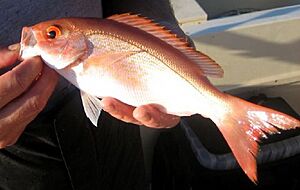Vermilion snapper facts for kids
Quick facts for kids Vermilion snapper |
|
|---|---|
 |
|
| Conservation status | |
| Scientific classification | |
| Synonyms | |
|
The vermilion snapper is a bright red fish that lives in the ocean. It's also known by other names like clubhead snapper or beeliner. This fish is a type of ray-finned fish and belongs to the snapper family, called Lutjanidae. You can find it naturally in the western part of the Atlantic Ocean.
Contents
About the Vermilion Snapper
The vermilion snapper has a long, oval-shaped body. It has a short snout and a small mouth. Its lower jaw sticks out a little bit. This fish has two pairs of nostrils on its snout. These are simple holes, one in front and one in the back.
What Does It Look Like?
The vermilion snapper is mostly bright red. Its lower sides turn pink, and its belly is whitish. It has short, wavy blue lines on its sides above the lateral line. These lines are made by spots on its scales. Sometimes, there are yellow streaks below the lateral line.
Its fins also have distinct colors. The anal fin is reddish-pink. The tail fin is red with a black edge. The dorsal fin, on its back, is red with a yellow edge. The pectoral fins, near its gills, are red.
This fish can grow up to 60 centimeters (about 2 feet) long. However, it's more common to see them around 35 centimeters (about 14 inches). The heaviest vermilion snapper ever recorded weighed 3.2 kilograms (about 7 pounds).
Where Vermilion Snappers Live
The vermilion snapper lives in the western Atlantic Ocean. You can find it from North Carolina and Bermuda, south along the U.S. coast to the Bahamas. It also lives throughout the Gulf of Mexico and the Caribbean Sea. Its range extends south along the eastern coast of South America, all the way to Brazil.
Their Ocean Home
These fish live in waters that are 20 to 300 meters (about 65 to 980 feet) deep. Adult vermilion snappers prefer moderate depths. They often live near rocks, gravel, or sandy areas. These spots are usually close to the edge of the continental and island shelves. Younger fish, called juveniles, live in shallower waters.
Vermilion Snapper Life Cycle
Vermilion snappers often gather in large groups, called schools. They sometimes swim with other red snapper species. This is especially true for younger fish.
What They Eat
The vermilion snapper is a predator. This means it hunts and eats other creatures. It looks for food on the ocean floor and in the open water. Their diet includes small fish, shrimp, crabs, and other invertebrates.
Reproduction
The spawning season for vermilion snappers varies by location. In the Gulf of Mexico and off the eastern U.S. coast, they spawn from mid-April to mid-September. Off Trinidad and Tobago, they spawn all year, with a peak from June to November. Near Brazil, spawning happens in February and March.
Vermilion snappers grow slowly. They can live for more than 15 years. They become ready to reproduce when they are between 1 and 2 years old.
Fishing and Protecting Vermilion Snappers
The vermilion snapper is a popular fish for fishing. Many people catch them for commercial, small-scale, and recreational purposes. They are caught using fishing lines, trawling nets, and traps. The meat of the vermilion snapper is considered good to eat. Sometimes, it is even sold as red snapper.
Conservation Efforts
The IUCN (International Union for Conservation of Nature) lists the vermilion snapper as a Vulnerable species. This is because too many are being caught in many areas. This has led to a decrease in their population by up to 30%.
In U.S. waters, there are three main groups of these fish. Two groups are just for vermilion snappers in the southern Atlantic and Gulf of Mexico. The third group is a mix of snappers in the Caribbean. Currently, none of these groups are considered to be overfished.


